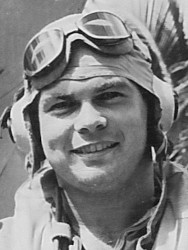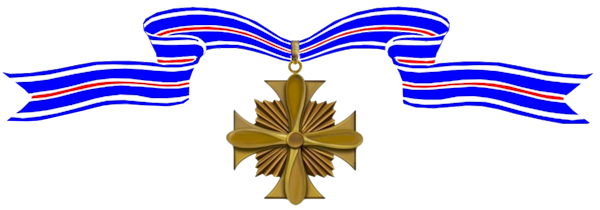John Maas became a World War II Marine Corps ACE, credited with shooting down FIVE enemy aircraft in aerial combat and in assisting in the destruction of a sixth enemy airplane.

–
Born:
,
Home:
,
Buried:
,
Cemetery:
Awards Received
-

Distinguished Flying Cross
-

Distinguished Flying Cross
-

Distinguished Flying Cross
-
Distinguished Flying Cross
Service:
United States Marine CorpsRank:
Second LieutenantBatallion:
Marine Fighter Squadron 112 (VMF-112)Action Date:
November 12 & 14, 1942 & January 31, 1943
The President of the United States of America takes pleasure in presenting the Distinguished Flying Cross to Second Lieutenant John Bernard Maas, Jr. (MCSN: 0-9017), United States Marine Corps, for heroism and extraordinary achievement while participating in aerial flight as Pilot of a Fighter Plane in Marine Fighter Squadron ONE HUNDRED TWELVE (VMF-112), in action against enemy Japanese forces in the Solomon Islands Area on 12 and 14 November 1942 and on 31 January 1943. When a force of our aircraft on an important offensive mission was intercepted by six fighters, Second Lieutenant Maas, section leader in a flight of six planes, courageously engaged the attackers and sent one hostile craft hurtling into the water, thereby contributing to the disruption of the enemy attack. In another flight he shot down one aircraft while his men destroyed eighteen others of a large formation of Japanese bombers about to attack friendly ships off Lunga Point, Guadalcanal Island. During a flight against installations on Vella Lavella Island our dive bombers were attacked by ten Zero-type aircraft over Kolombangara Island. By his expert marksmanship, he accounted for one of the eight planes destroyed by our fighters, thereby enabling the bombers to effectively complete their mission. His aggressive fighting spirit was in keeping with the highest traditions of the United States Naval Service.
-
Distinguished Flying Cross
Service:
United States Marine CorpsRank:
MajorBatallion:
Marine Fighting Squadron 322 (VMF-322)Action Date:
May 12 – 16, 1945
TAF Ryukyus SPOT: 00812The President of the United States of America takes pleasure in presenting a Gold Star in lieu of a Second Award of the Distinguished Flying Cross to Major John Bernard Maas, Jr. (MCSN: 0-9017), United States Marine Corps, for heroism and extraordinary achievement while participating in aerial flight as a Pilot, Flight Leader and Division Leader in Marine Fighting Squadron THREE HUNDRED TWENTY-TWO (VMF-322), during operations against enemy Japanese forces in the Ryukyu Islands Area, from 12 to 16 May 1945. Completing his twentieth mission during this period, Major Maas boldly carried out a rocket, bombing and strafing attack in the face of intense hostile anti-aircraft fire leaving four enemy buildings damaged and burning and, in addition, participated in a strike and combat air patrols, thereby contributing materially to the success of his squadron. By his leadership, courage and devotion to duty throughout, Major Maas upheld the highest traditions of the United States Naval Service.
-
Distinguished Flying Cross
Service:
United States Marine CorpsRank:
Lieutenant ColonelAction Date:
January 10 – 13, 1953
The President of the United States of America takes pleasure in presenting a Second Gold Star in lieu of a Third Award of the Distinguished Flying Cross to Lieutenant Colonel John Bernard Maas, Jr. (MCSN: 0-9017), United States Marine Corps, for extraordinary achievement while participating in aerial flight against the enemy in Korea from 10 January 1953 to 13 January 1953, during a series of massed aerial assaults on a heavily defended bridge complex in the vicinity of Sinanju. Confronted by intense defensive fire and under constant threat of attack by numerically superior jet interceptors, Lieutenant Colonel Mass, Commanding Officer of a Marine Jet Fighter Squadron of jet fighter-bombers led his squadron on four successive bombing missions against the major enemy objective. On each of these strikes, he led his flight in coordinated bombing and strafing attacks against the enemy. Diving through accurate and intense barrages of hostile radar-controlled anti-aircraft fire, he repeatedly scored direct bomb hits that clearly marked the targets for the remainder of the flight. Lieutenant Colonel Mass’ exceptional bombing accuracy and exemplary leadership were responsible for the success of four separate strikes that destroyed three bridges, twenty boxcars and inflicted numerous rail cuts. His courageous conduct, outstanding initiative and steadfast devotion to duty throughout reflected great credit upon himself and were in keeping with the highest traditions of the United States Naval Service.

